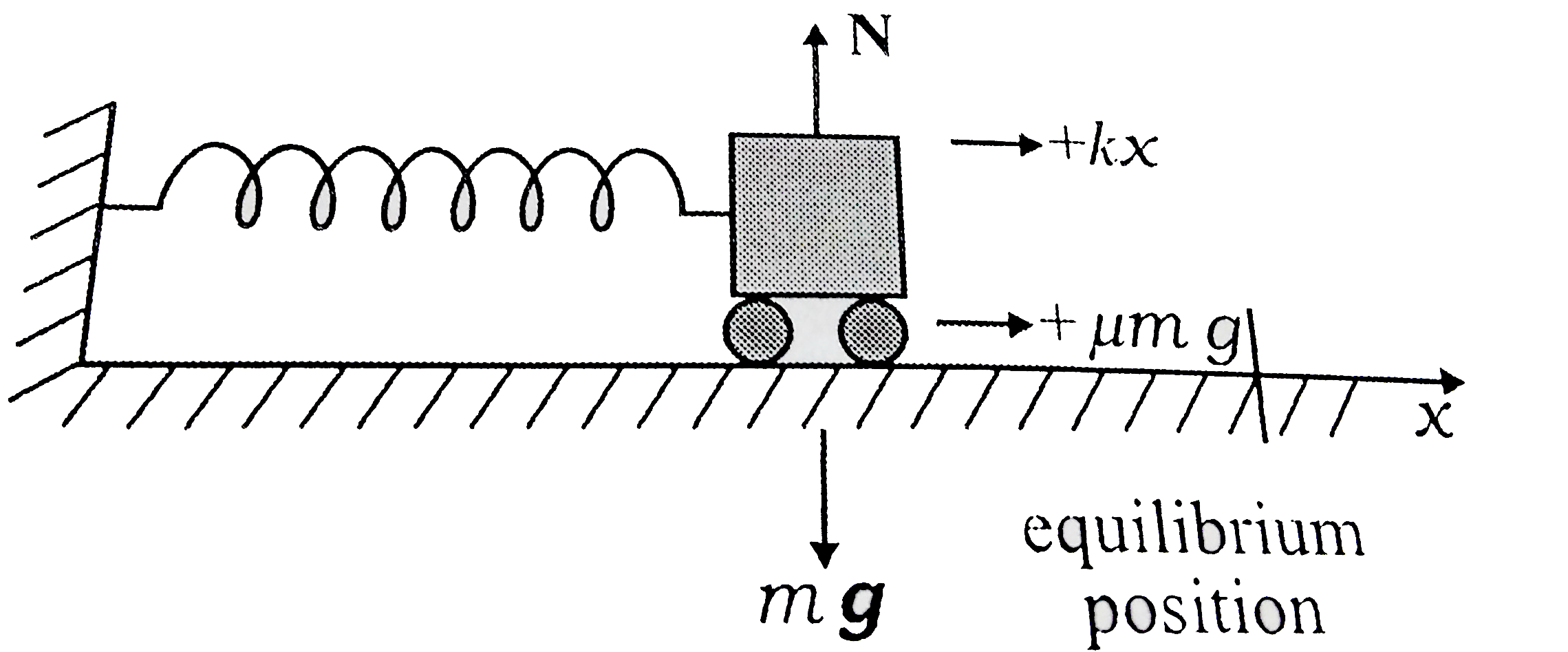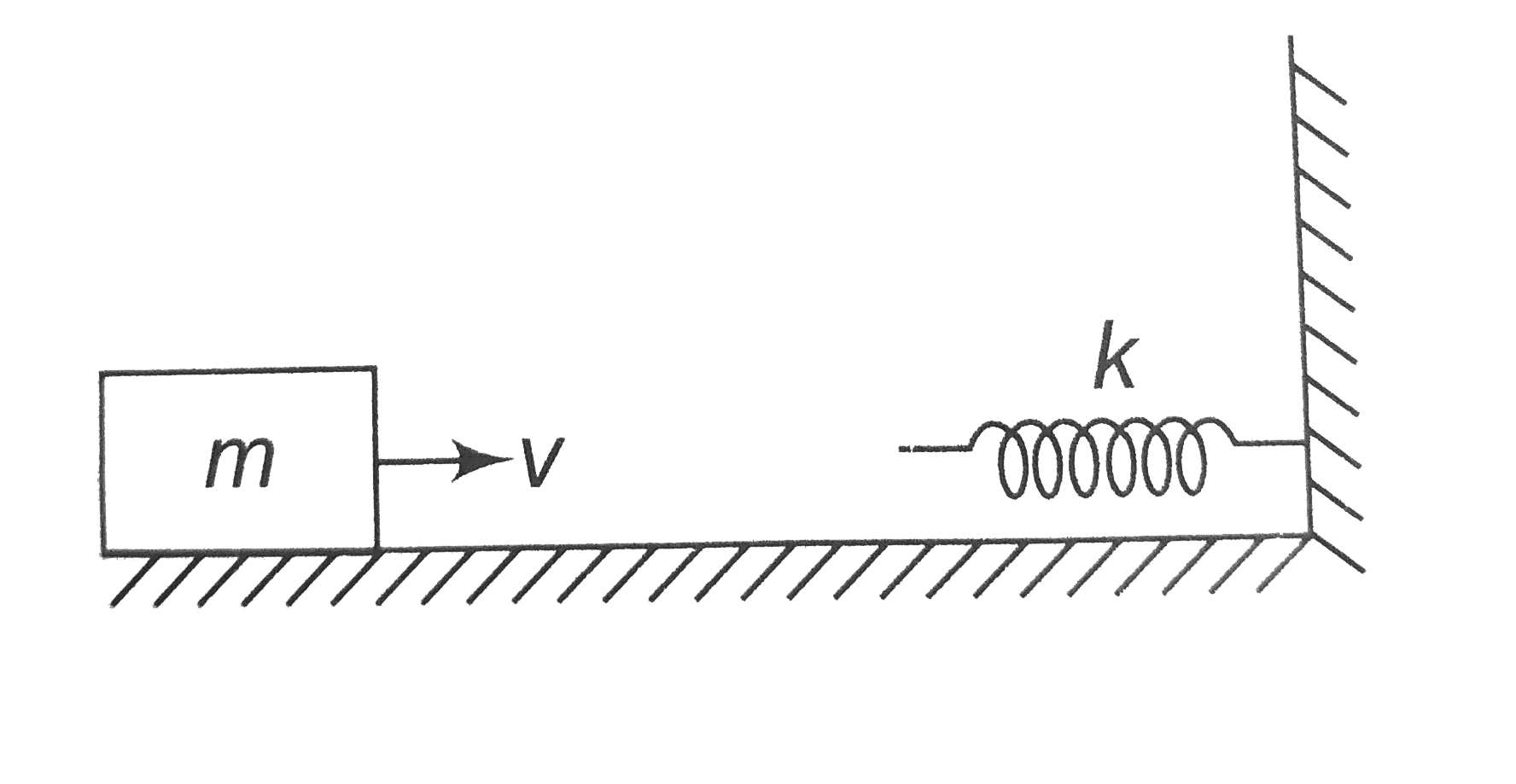Consider Example 8, taking the coefficient of friction, μ, to be 0.5 and calculate the maximm compression of the spring.
In presence of friction, both the spring force and the frictionless force act so as to oppose the compression of the spring as shown in fig.
We invke the work-energy theorem, rather than the conservation of mechanical energy. The change in kinetic energy is

ΔK=Kf−Ki=0−12mv2
The work done by the net force is
W=−12kx2m−μmgxm
Equating we have
12mv2=12kx2m+μmgxm
Now, μmg=0.5×103×10=5×103N (taking g=10.0 mso−2). After rearranging the above equation we obtain the following quadratic equation in the unknown xm
kx2m+2μmgxm−mv2=0
xm=−μmg+[μ2m2g2+mkv2]1/2k
where we take the positive square root since xmis positive. Putting in numerical values we obtain.
Xm=1.35m
Which, as expected, is less than the result
If the two forces on the body consist of a conservation force Fc and a non-conservative force Fnc. the conservation of mechanical energy formula will have to be modified. By the WE theorem.
(Fc+Fnc)Δx=ΔK ltrbgt But, FcΔx=−ΔV
Hence, Δ(K+V)=FncΔx
ΔE=FncΔx
where E is the total mechanical energy. Over the path this assumes the form.
Ef−Ei=Wnc
Where Wnc is the total work done by the non-conservative forcer over the path. Note that the unlike the conservative force. Wnc depends on the particular path i to f.
Topper's Solved these Questions
Similar Questions
Knowledge Check
- Question 1 - Select One
A block of mass m is moving with a speed v on a horizontal rough surface and collides with a horizontal mounted spring of spring constant k as shown in the figure .The coefficient of friction between the block and the floor is μ The maximum compression of the spring is
 A−μmgk+1k√(μmg)2+mkv2Bμmgk+1k√(μmg)2+mkv2C−μmgk+1k√(μmg)2−mkv2Dμmgk+1k√(μmg)2+mkv2
A−μmgk+1k√(μmg)2+mkv2Bμmgk+1k√(μmg)2+mkv2C−μmgk+1k√(μmg)2−mkv2Dμmgk+1k√(μmg)2+mkv2 - Question 2 - Select One
A block of mass m is attached to one end of a mass less spring of spring constant k. the other end of spring is fixed to a wall the block can move on a horizontal rough surface. The coefficient of friction between the block and the surface is μ then the compession of the spring for which maximum extension of the spring becomes half of maximum compression is .
A2mgμkBmgμkC4mgμkDNone of these - Question 3 - Select One
Two blocks each having mass m is attached to each other with a spring having force constant k. The system is placed on a rough horizontal surface having coefficient of friction μ. The maximum initial compression, that can be given to the spring so that when released the blocks do not move is
 A2μmg/kBμmg/kCzeroDnot possible
A2μmg/kBμmg/kCzeroDnot possible
Consider Example 22. Takin the coefficient of friction, μ to be 0.5, calculate the maximum compression of the spring.
View SolutionWhen the coefficient of friction between the weight and the palte is μ.
View SolutionA block of mass m is attached to one end of a mass less spring of spring constant k. the other end of spring is fixed to a wall the block can move on a horizontal rough surface. The coefficient of friction between the block and the surface is μ then the compession of the spring for which maximum extension of the spring becomes half of maximum compression is .
View SolutionTwo blocks each having mass m is attached to each other with a spring having force constant k. The system is placed on a rough horizontal surface having coefficient of friction μ. The maximum initial compression, that can be given to the spring so that when released the blocks do not move is
 View Solution
View SolutionFree end of an ideal spring of spring constant 100 N/m is at a distance 1 m from a vertical block of mass 2 kg moving on rough surface with initial speed 8 m/s as shown in figure. If coefficient of friction is 0.7, then maximum compression in spring is (g=10ms−2)
 View Solution
View Solution

